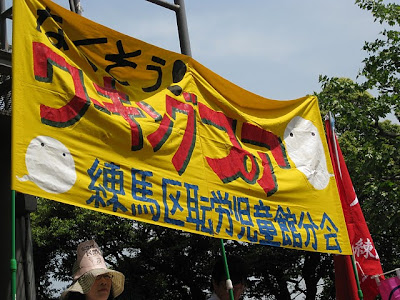
“Do we have an image for what it means to work?”
These last weeks I’ve been pondering Giovanni’s excellent post on our failures of memory and representation, which are also failures of a particular type of political courage. Alongside class analysis and understanding, vital too, we need certain visual vocabularies to see one another and to take the measure of our movement’s state and outlook.

[There I am in the middle, looking as happy as the day is long.]
No longer knowing that vocabulary once it changed visual languages was one of the many usefully bewildering experiences I found living in Tokyo. You can – and should – read trade union history, but there’s a whole structure of feeling evoked by the movement’s iconography and rituals, one which needs to be lived to begin to be understood. I took these photographs last year at a May Day rally in Hibiya Park (a place with a rich but well-hidden working-class historical legacy); they tell an interesting story.

What struck me that day, amidst other hopeful signs, was how carefully considered the imagery of work was at this demonstration. There’s a long tradition of this at May Days the world over, of course – workers marching in their uniforms, union banners depicting a model of their particular trade – but what’s different here is the uncovering or re-presenting of work and workers more usually invisible, or not considered as a part of traditional accounts of strength and resistance.

The Hibiya Park May Day was and is defiantly militant, stressing political opposition to militarism and war as much as wages and safety, but look at who’s here as the bearers or symbols of that militancy: the ‘working poor’, the young, women and women’s unions, aged care workers. The marginalised and invisible, in other words, of both neoliberalism and, all too often, the mainstream of the organized labour movement.

[No more working poor! Nerima Ward Workers at the Child Welfare Residential Facility]
The imagery and self-representation these groups are experimenting with – and their organizational forms, too, about which Kaye Broadbent’s research is enlightening – help show how these questions of memory and representation are questions of strategy, too.

[Stop workers getting the ax. Workers are not disposable /We need a political solution to promptly solve the Japan Railways struggle!]
There’s a much wider question hovering behind all this: how are we to make use of tradition in these bad new days? Making work visible is one step in approaching that question: making our own movement’s current composition clear to itself is another.


No comments:
Post a Comment